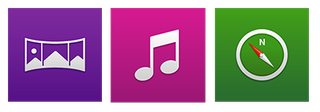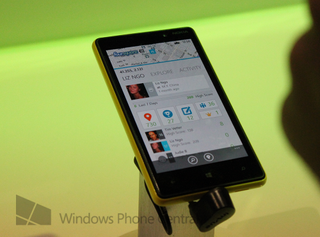Interview: Marco Argenti, Nokia SVP of Developer and Marketplace division

Whilst at MWC, Windows Phone Central had the chance to sit down with Marco Argenti, Senior Vice President of the Developer and Marketplace division at Nokia. We had just been checking out the new partner apps being shown off in Nokia’s sizeable booth and were keen to hear more about the relationships Nokia are continuing to build with developers both commercial and indie, especially following the news of Nokia’s new imaging and HERE API features.
You can find the full write up of that discussion after the break.
On Nokia’s new services and APIs
Our interview kicked off with a conversation about the new API’s Nokia are making available to developers, both how they are being used and why Nokia is offering the new services out to developers.
Marco, clearly prepared for our opener, tells us that Nokia are bringing the strategy of differentiating from other Manufacturers forward into the app realm. The new APIs can be separated in to three categories, each corresponding to Nokia’s differentiators.
They are Imaging, Music and Location.

For Imaging, Marco talks about the new sequencer capability, part of the framework which makes up Cinemagraph, you can see a very inventive use of the system in Burton’s app, allowing time lapsed images as an object moves across a static background (for instance a Snowboarder making a jump). Nokia are also keen to talk about image processing and filtering into the Windows Phone API, as well as allowing developers to tweak various settings (such as ISO) after a moment has been captured.
Music revolves around integration with Nokia music, in that third party developers are able to provide access to your playlists, both online or offline. Third party apps such as Burton are already demonstrating this by showing you relevant playlists and then jumping out into the Nokia music app when you tap.
Get the Windows Central Newsletter
All the latest news, reviews, and guides for Windows and Xbox diehards.
Location for Nokia is now all encompassed under the HERE brand. Marco defines two layers for developers to leverage. First is the core data layer, what Marco calls the “index of the world”. This is the mapping data, vector based rendering for normal maps and tiles for more complex data such as aerial photos. The second layer is the utilizing of extended APIs, these are available to Nokia’s partners and designed to be more deeply integrated into an app. All these APIs allow for use of the technology in HERE transport, drive (including traffic info) and CityView. These partner apps can still function without extended capabilities on non-Lumia devices, the capabilities of each device are identifies through a combination of the Device Information APIs in Windows Phone, and specifics in the app’s manifest.
We asked Marco to tell us a little more about what the Nokia HERE platform offered to developers, including how it was an improvement over Bing maps. To this question he answers by highlighting the low bandwidth mode and offline capabilities offered by the HERE platform. With low bandwidth he is referring to the vector based rendering, which of course requires far less data to be transferred than tile based systems. It is also true that with offline maps delivered in Windows Phone 8, all calls to the SDK for mapping use whatever data has been already downloaded rather than having to call their own mapping data.
On working with partners and exclusives
A topic of particular interest to many here at Windows Phone Central is Nokia’s exclusive app ecosystem, something we introduced as a topic by asking about how the new apps we had been exploring earlier had been conceived, how is it that companies come to working with Nokia directly rather than employing other developers? Do Nokia approach the relevant companies? Or is it the other way around?
Marco showed some hesitance around the specifics of this process. He explained that who approaches who was not of particular importance, carefully avoiding the question. Instead he says that the process involves engaging very deeply with the relevant parties. He told us that most of the initial conversations happen around the design table with these companies, identifying how the partnership will progress and what Nokia can bring, such was the case with GoPro.

In the case of Foursquare though, we did manage to establish some background. Marco informs us that the inflection point for Foursquare was with the release (and subsequent success) of Windows Phone 8. At that point Foursquare and Nokia shared some similar goals regarding location based services and discovery, and it became clear that working together was mutually beneficial. Of course Nokia are looking to unify their experience, and desired a single conversation about their entire range, both Asha and Lumia.
We asked Marco about the Nokia exclusives model as well, if there was one model which was followed when approaching these apps. Marco explained that there is no particular fixed timeframe or any set of business models. Instead, when Nokia have worked to assist in the development or marketing of an app, a fixed deal is agreed based entirely on that app. In some cases this will be having unique features only on Lumia, in others it will be about an exclusivity period. Marco made it clear that Nokia’s intention here is to work on quality of the apps available for the Lumia range, rather than blocking any kind of experience on the wider Windows Phone ecosystem.
On supporting developers
The last topic of conversation between Windows Phone Central and Mr. Argenti was the work which Nokia are doing to aid Windows Phone developers. We discussed how Nokia’s distribution channels, Ad Exchange program, and developer champions are reaching out to help developers deliver quality content, and subsequently consumers enjoy a higher standard of software on their Windows Phone.
We began by asking how developers can get involved with Nokia if they are looking for assistance or to broaden their app’s distribution. Marco says that Nokia are looking to reward quality, either with advertising on their behalf or through device pre-loads. While some developers will have success with a ‘cold call’ to a Nokia staff member, the best solution is to either get in touch with a Nokia developer champion, or to use the Dvlup website, recently launched in the UK and already available in the US and Canada.

Dvlup can be compared to foursquare in that it rewards engagement with badges and points, which in turn will help them grow their app. When using Dvlup, by following challenges involving updates to their apps and a level of quality according to ratings in the marketplace, developers earn points. These points (or XP on the site) can be exchanged for advertising space, or for prizes such as Nokia devices. Dvlup also hold live real time competitions to build app ideas which also reward members with XP.
Nokia’s champion developers are elite developers who are selected by Nokia to work part time aiding the community around them. We’ve seen similar ideas from Microsoft directly where champions are responsible for organising networking events, providing assistance to developers when they get stuck or need advice.
With Nokia Ad Exchange, we were curious to find out how Nokia’s offering is different to the competition, what does their network offer that the likes of Microsoft or the popular AdDuplex do not? Marco is keen to emphasise that with Ad Exchange, Nokia is guaranteeing high yield on advertising campaigns, focusing on specifically relevant geographies rather than attempting to appeal to the whole globe. Nokia have aggregated 120 different networks, with advert selection performed whilst being aware of what is on that user’s device and what may appeal to that user through intelligent data processing. The Ad Exchange system is integrated with your Microsoft developer account and includes a Business Developer Kit (BDK) designed to assist each developer with billing, how to distribute and monetize their apps, and the trial before buying model.
In Summary
Nokia have made no secret of their desire to focus on quality apps rather than flooding the marketplace with meaningless numbers, and in our time with Marco Argenti this message was clearer than ever. He is clearly a man passionate about engagement with all types of developers, whether indie or enterprise. By offering assistance not just at a technical level with extended APIs, but also at a business level with advertising and distribution, here at Windows Phone Central we can think of no possible reason why every developer out there shouldn’t look into Nokia’s premium developer package (it includes a Microsoft Windows Phone publisher account) and get involved with the Dvlup program. For consumers, we hope you’re as excited as we are to see what great new apps and services Nokia can bring to the Windows Phone ecosystem in the future.
